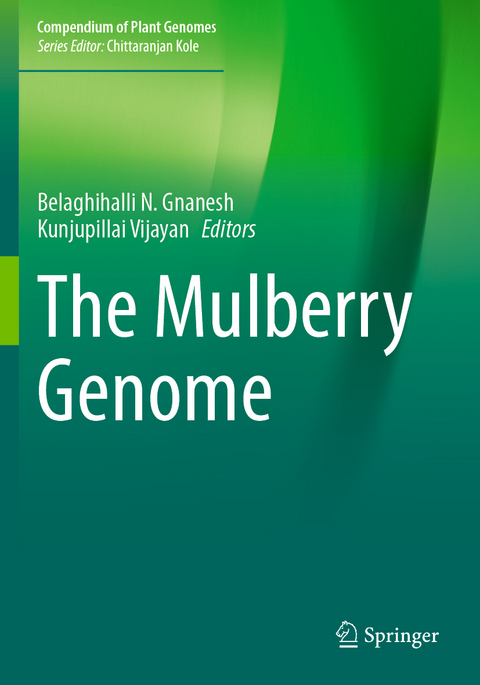
The Mulberry Genome
Springer International Publishing (Verlag)
978-3-031-28480-9 (ISBN)
This book is the first comprehensive compilation of current knowledge on mulberry (Morus L.) covering botany, cytogenetics, biodiversity, genetics and breeding, tissue culture and genetic transformation, biotic and abiotic stresses, molecular mapping, QTL identification, whole genome sequencing and elucidation on functional genomics. As mulberry is one of the most economically important trees in Asian countries, it has attracted the attention of both academicians as well as industrialists. Being highly heterozygous due to long juvenile life coupled cross pollination among species, the genetics of this important crop species is yet to be unravelled. Nonetheless, the recent success of sequencing the genomes of haploid and diploid domesticated species has ushered in an era of intense molecular and genetic research to understand this crop well for its better utilization for mankind.
In this book, efforts have been made to bring together key information on origin and distribution, taxonomy, morphological features, economic importance, abiotic stress responses, disease and pest resilience, current breeding strategies and their constraints, progress and prospects of gene mapping, elucidation of genes controlling metabolic and physiological pathways, and their utilization in crop improvement which are elaborated in about 250 pages over 13 chapters authored by globally leading experts on the species presented.This book is useful to the sericulture community in the world in general and students, teachers, and scientists in the academia for forage and fruit production, genetics, breeding, pathology, entomology, physiology, molecular genetics, in vitro culture and genetic engineering, and structural and functional genomics. This book is also useful to seed and biofuel industries.
Dr Belaghihalli N. Gnanesh is working as a Professor and Dean at Sampoorna International Institute of Agricultural Science and Horticultural Technology, Maddur, Karnataka recognized by the University of Mysore, India. He has extensive research experience in the field of germplasm resources, genomics, and disease-resistant breeding. He has worked with Agriculture Agri-Food Canada (AAFC), Winnipeg as a Natural Sciences and Engineering Research Council of Canada (NSERC) Visiting Fellow on marker development and molecular breeding of oats and also worked at the University of Manitoba, Canada on canola blackleg disease resistance. He has been awarded the prestigious Science and Engineering Research Board, Ramanujan fellowship, instituted by the Government of India. His major focus at Central Sericultural Research Training Institute, Mysore was on mulberry transcriptomes, genome sequencing, SNP discovery, linkage mapping, and molecular identification of Fusarium species complex associated with root rot of mulberry. He has published more than 40 quality research articles and several book chapters.
Dr Kunjupullai Vijayan is a renowned research scientist with extensive experience in plant breeding, genetics, cytogenetics, molecular phylogeny, genomics, tissue culture and germplasm development. He has more than 35 years of research experience in national and international Research Institutes. His research findings have been published in more than 130 National and international journals, proceedings, and book publications. He worked at Central Silk Board as a senior scientist and at Institute of Plant and Microbial Biology, Academia Sinica, Taipei, Taiwan as a Post-Doctoral Research Associate. He is an expert on genomic relationships of the genus Morus. He has collaborated with many mulberry researchers around the world. He has been involved in the development of several mulberry varieties suitable for different agro-climatic conditions. He has also worked out, for the first time, a very comprehensive phylogeny of the genus Camellia.
Background of Mulberry: Origin and Distribution, Domestication, Taxonomy, Cytology and Biodiversity.- Cultivation, Utilization and Economic benefits of mulberry in an Indian Context.- Mulberry Breeding for higher leaf Productivity.- Mulberry genome analysis: Current status, challenges, and future perspective.- Relationship between genome size and ploidy level in mulberry.- Transcriptomics: Current status and future prospects for identifying trait specific genes in mulberry.- Proteomics in mulberry.- Current status and importance of DUS testing in Mulberry.- Molecular diagnostics of soil borne and foliar diseases of mulberry: Present trends and future perspectives.- Transgenic Mulberry (Morus spp.) for Stress Tolerance: Current Status, Challenges and Future Perspectives.- Application of mulberry and mulberry silkworm by products for medical use.- Application of green synthesized nanoparticles in sustainable mulberry production: current trends and future perspectives.- Future Perspectives of Mulberry Genomic Research.
| Erscheinungsdatum | 19.06.2024 |
|---|---|
| Reihe/Serie | Compendium of Plant Genomes |
| Zusatzinfo | XIX, 298 p. 37 illus., 30 illus. in color. |
| Verlagsort | Cham |
| Sprache | englisch |
| Maße | 178 x 254 mm |
| Themenwelt | Naturwissenschaften ► Biologie ► Botanik |
| Schlagworte | comparative genomics • Crop improvement • functional genomics • Genome sequence • Molecular mapping • Mulberry • sericulture |
| ISBN-10 | 3-031-28480-1 / 3031284801 |
| ISBN-13 | 978-3-031-28480-9 / 9783031284809 |
| Zustand | Neuware |
| Informationen gemäß Produktsicherheitsverordnung (GPSR) | |
| Haben Sie eine Frage zum Produkt? |
aus dem Bereich


